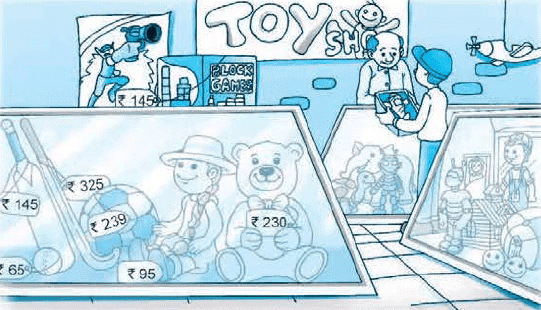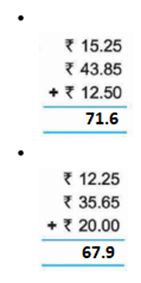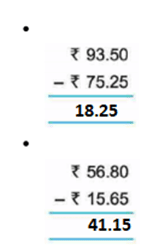Class 3 Maths - Money - CBSE Worksheets Solutions

Q1: Express the following in short form:
a) 40 rupees 40 paise = ₹ 40.40
b) 25 rupees 10 paise = ₹ 25.10
c) 7 rupees 60 paise = ₹ 7.60
Q2: Write in words:
a) ₹ 35.25 = Thirty five rupees twenty five paise
b) ₹ 0.75 = Seventy five paise
c) ₹ 2.12 = Two rupees twelve paise
Q3: Check the prices of various things at the shop and find the cost of the following:
 a) A hockey stick and a cricket bat
a) A hockey stick and a cricket bat
= 325 + 145 = Rs.470
b) A teddy bear and a doll
= 230 + 95 = Rs.325
c) A cricket bat and a ball
= 145 + 65 = Rs. 210
Q4: Convert the following rupees into paise:
a) ₹ 88.88
1 rupee = 100p
8800 + 88 = 8888p
b) ₹ 32.45
3200 + 45 = 3245p
c) ₹ 4.06
400 + 06 = 406p
Q5: Convert the following into paise:
a) ₹ 7 and 35 paise
1 rupee = 100p
700 + 35 = 735p
b) ₹ 8 and 42 paise
1 rupee = 100p
800 + 42 = 842p
c) ₹ 4 and 95 paise
1 rupee = 100p
400 + 95 = 495p
d) ₹ 87
1 rupee = 100p
8700p
e) ₹ 6 and 75 paise
1 rupee = 100p
600 + 75 = 675p
Q6: Convert the following into rupees:
1 rupee = 100 p
a) 2100 p
Rs. 21
b) 700 p
Rs. 7
c) 1400 p
Rs.14
d) 75 p
Rs.0.75
e) 6500 p
Rs.65
Q7: Fill in the blanks
a) 1045 paise = ₹ 10.45
b) 8 rupees and 15 paise = 8.15 paise
c) 2960 paise = ₹ 29.60
Q8: Convert the following into paise:
1 rupee = 100p
a) ₹ 57.75
5700 + 75 = 5775p
b) ₹ 19.50
1900 + 50 = 1950p
c) ₹ 12.96
1200 + 96 = 1296p
d) ₹ 80.80
8000 + 80 = 8080p
e) ₹ 97.65
9700 + 65 = 9765p
Q9: Solve:
a) Mona bought a pencil for ₹ 15, a pen for ₹ 25.50 and a notebook for ₹ 45. 75. Find the total money spent by her.
Ans: Spent on pencil = ₹ 15
Spent on pen = ₹ 25.50
Spent on notebook = ₹ 45. 75
Total money spent = ₹ 15 + ₹ 25.50 + ₹ 45. 75 = ₹ 86.25
b) Roger went for shopping and bought a toy for ₹ 25.75 and a bat for ₹ 40.20 . How much money did he spend in all?
Ans: Spent on toy = ₹ 25.75
Spent on bat = ₹ 40.20
Total money spent = ₹ 25.75 + ₹ 40.20 = ₹ 65.95
c) Radha gave ₹ 56.90 to her daughter and ₹ 35.50 to her son . Find the total money given by Radha to her children.
Ans: Money given to daughter = ₹ 56.90
Money given to son = ₹ 35.50
Total money given =₹ 56.90 + ₹ 35.50 = ₹ 92.4
d) Sushma bought potatoes for ₹ 12.50, tomatoes for ₹ 16.25 and onions for ₹ 20.00. How much did she spend in all?
Ans: Spent on Potatoes = ₹ 12.50
Spent on Tomatoes = ₹ 16.25
Spent on onions = ₹ 20.00
Total money spent = ₹ 12.50 + ₹ 16.25 + ₹ 20.00 = ₹ 48.75
Q10: Add the following by converting into paise:
a) ₹ 33.50 + ₹ 29.68
3350 + 2968 = 6318
b) ₹ 69.70 + ₹ 25.25
6970 + 2525 = 9495
c) ₹ 45.50 + ₹ 25.50
4550 + 2550 = 7100
d) ₹ 58.75 + ₹ 29.50
5875 + 2950 = 8825
Q11: Add each of the following

Q12: Solve the following
a) A woman had ₹ 180 with her. She bought vegetables for ₹ 65.50. How much money was left with her?
Ans: Total money = ₹ 180
Vegetables bought = ₹ 65.50.
Money left = ₹ 180 - ₹ 65.50 = ₹114.50
b) The cost of a book is ₹ 75.50. Shikha has only ₹ 69.25. How much more money does she need to buy the book?
Ans: Cost of book = ₹ 75.50
Shikha has = ₹ 69.25
Money she wants more = ₹ 75.50 - ₹ 69.25 = ₹ 6.26
c) Rishabh wants to buy a hat that costs ₹ 96.50. He has ₹ 57. How much more money does Rishabh need to buy the hat?
Ans: Cost of hat = ₹ 96.50
Money he has = ₹ 57
Money he wants more = ₹ 96.50 - ₹ 57 = ₹ 39.50
Q13: Subtract the following by converting them into paise:
a) ₹ 65.75 - ₹ 28.36
6575 - 2836 = 3739
b) ₹ 20.50 - ₹ 14.30
2050 - 1430 = 620
c) ₹ 95.50 - ₹ 53.30
9550 - 5330 = 4220
d) ₹ 52.40 - ₹ 16.10
5240 - 1610 = 3630
Q14: Subtract the following:

Q15: Which is lesser: ₹ 100.05 or ₹ 100.50? ______
Ans: ₹ 100.05 < ₹ 100.50
Q16: How much is ₹ 25.50 less than ₹ 50? ______
Ans: 50 - 25.50 = 24.50
Q17: ₹ 36.40 = 3640 paise.
Q18: Find the total money in each bill. Also, in each case, find the amount received as change.

Q19: In short, 200 rupees 5 paise can be written as Rs.200.05.
Q20: In short, 40 paise can be written as Rs.00.40.
|
18 videos|120 docs|25 tests
|
FAQs on Class 3 Maths - Money - CBSE Worksheets Solutions
| 1. What is the importance of teaching money management to children? |  |
| 2. How can parents effectively teach their children about money? |  |
| 3. What are some practical ways to teach children about budgeting? |  |
| 4. How can parents teach children about the difference between needs and wants when it comes to money? |  |
| 5. How can parents encourage their children to save money? |  |
















